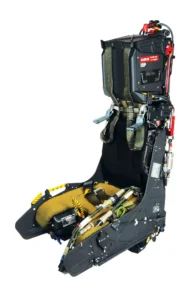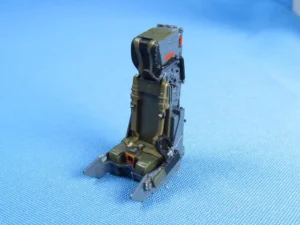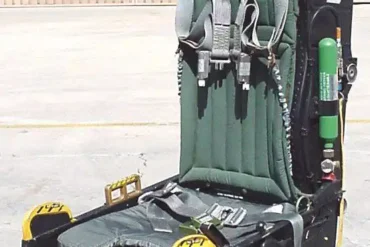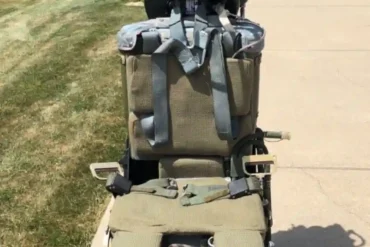The F/A-18 Hornet is one of the most iconic aircraft in military aviation, known for its versatility, high performance, and precision in combat. Integral to its operation and pilot safety is the ejection seat—a crucial life-saving system that enables the pilot to safely eject from the aircraft in emergency situations. This article will delve deeply into the F/A-18 ejection seat, its development, design, function, and its importance in ensuring the safety of naval aviators.
History and Development of the F/A-18 Ejection Seat
The F/A-18 Hornet, a product of McDonnell Douglas (now Boeing), has been in service since the 1980s, and during its development, one critical factor was the design and functionality of its ejection seat. The ejection seat plays a vital role in saving the lives of aircrew members during emergency situations such as aircraft malfunction or enemy fire. Originally, the F/A-18 aircraft was fitted with the ESCAPAC series ejection seats, which had been in use in various U.S. Navy aircraft. However, when the time came to choose a new ejection seat for the Hornet, Martin-Baker emerged as the supplier.
In the competitive selection process, Martin-Baker’s Mk. 10 ejection seat won the contract, becoming the SJU-5/6 series used in the F/A-18. This seat, like others from Martin-Baker, was designed with the highest standards of performance and reliability, making it a key component in the F/A-18’s success.
Why Martin-Baker?
Martin-Baker has a long history of designing innovative and reliable ejection seats. The company’s success can be attributed to its cutting-edge engineering and focus on safety and performance. The Mk. 10 seat selected for the F/A-18 Hornet, like its predecessors, incorporates a range of advanced features designed to ensure safe ejection at both high and low altitudes and speeds.
Key Features of the F/A-18 Ejection Seat
The F/A-18 ejection seat is designed to provide the pilot with maximum safety during emergency ejections. Understanding the components of this seat helps in appreciating the level of engineering that goes into ensuring the safety of the pilot.
Main Beam Assembly (MBA) and Seat Bucket
The ejection seat’s Main Beam Assembly (MBA) is the core of the seat’s structure, supporting critical components such as the seat bucket, shoulder harness restraint, and headrest parachute pack. The MBA also integrates other sub-assemblies including the drogue deployment unit and parachute deployment rocket. These components ensure the seat functions smoothly during an ejection.
The seat bucket, which holds the pilot during ejection, is designed to accommodate a wide range of body sizes. It is specifically engineered to maintain the proper alignment of the pilot’s body during the ejection sequence, reducing the risk of injury.
Leg Restraints and Garters
The leg restraint system is another crucial feature of the F/A-18 ejection seat. The seat is equipped with a set of garters that the pilot wears on his legs. These garters are connected to leg restraint lines that run from the cockpit floor through the front of the seat bucket. The restraint lines keep the pilot’s legs securely against the seat bucket as the seat is ejected. This system prevents the legs from flailing or becoming injured during the high-speed ejection.
Rocket-Assisted Ejection and Parachute Deployment
The rocket-assisted ejection system is a key feature of the F/A-18 ejection seat. Upon activation, a rocket motor fires, propelling the seat upward along the aircraft’s ejection rails. The drogue deployment unit, powered by a cartridge-generated gas, ensures that the seat is stabilized and that the parachute is deployed properly.
In the case of the SJU-5/6 seat, the parachute deployed is a GQ Type 5000, which is an integral part of the life-saving process. The rocket-assisted ejection provides the initial thrust, while the drogue parachute ensures that the pilot is stabilized and ready for the final parachute deployment.
Safety Mechanisms and Timing
The timed release mechanism is one of the most vital components in ensuring that the ejection seat operates properly. This mechanism ensures that the lap belt and other safety harnesses are released at the right time during the ejection sequence. Friction snubbers are also in place to prevent unwanted movement until the release occurs.
A critical aspect of the system is the ejection initiation handle. This handle, located on the seat bucket, allows the pilot to activate the ejection seat in an emergency. If the automatic system fails, there is a manual override to ensure that the pilot can still eject if necessary.
Adjustable Seat for Different Pilot Sizes
The F/A-18 ejection seat can accommodate a wide range of body sizes. The seat is designed to be adjustable, with up/down controls that allow the seat to be positioned according to the pilot’s size. The NACES (Navy Aircrew Common Ejection Seat) Mk. 14, which is used in the later variants of the F/A-18, is designed to be compatible with aircrew members ranging from the 3rd to the 98th percentile in terms of body size.
Ejection Speed and Altitude Capabilities
The F/A-18 ejection seat is capable of safe ejection at a wide range of speeds and altitudes. The maximum speed for ejection is 600 knots indicated airspeed (KIAS), while the seat is operable up to an altitude of 50,000 feet. This ensures that the pilot has a safe ejection option, even in extreme flight conditions. The seat is also designed to handle zero/zero ejections, meaning it can eject the pilot at low speeds and altitudes with no forward velocity or altitude, ensuring safe ejections at very low or hovering altitudes, such as during carrier takeoffs or landings.
Mk. 14 (NACES): The Evolved Ejection Seat

As the F/A-18 evolved, so did the ejection seat system. The Mk. 14 NACES (SJU-17) is the modern variant in use in the F/A-18 Super Hornet and other aircraft. With more than 2,500 Mk14 seats in service, this model has saved 138 aircrew members since its introduction.
The Mk. 14 was developed under the NACES program, awarded to Martin-Baker in May 1985. The goal was to create a high-performance ejection seat that could be used across multiple aircraft types, offering commonality benefits for the U.S. Navy and allied forces.
The Mk. 14 is currently in service with countries like the USA, Finland, Kuwait, Malaysia, Canada, Australia, and Switzerland. Its modular design ensures that it can be integrated into various aircraft, including the F/A-18 Hornet, the T-45 Goshawk, and more.
Advanced Features of the Mk. 14 Ejection Seat
The Mk. 14 offers several improvements over earlier designs, making it one of the most advanced ejection seats in the world. Key features include:
- Parachute Deployment: The seat uses a rocket-assisted parachute deployment system, ensuring rapid deceleration after ejection and a stable descent.
- Ejection Speed and Altitude: Like its predecessors, the Mk. 14 is capable of ejections at 600 KIAS and at altitudes up to 50,000 feet, ensuring its effectiveness in various operational environments.
- Adjustability: The Mk. 14 supports a wide range of crew sizes, from the 3rd percentile to the 98th percentile, ensuring compatibility with most pilots.
- Dual Ejection Options: The seat can be ejected using both an automatic and manual system, ensuring redundancy in case of failure.
The Role of the Mk. 14 in Modern Naval Aviation
The Mk. 14 NACES ejection seat has become the standard in many modern military aircraft. It serves not only as a life-saving system but also as a critical component in maintaining the safety of pilots in increasingly dangerous combat environments. As aircraft become faster, higher-flying, and more advanced, the demands on ejection seats grow. The Mk. 14 meets these challenges, providing a robust and adaptable system that can operate in a wide range of conditions.
Conclusion
The F/A-18 ejection seat is a cornerstone of pilot safety in modern naval aviation. The development and refinement of this critical component—especially the transition from the ESCAPAC seats to the Martin-Baker Mk. 10 and later the Mk. 14 NACES—have significantly improved ejection safety for naval aviators. With advanced features such as adjustable seating, rocket-assisted ejection, and parachute deployment systems, the ejection seat ensures that pilots have the best chance of surviving emergencies, whether at sea or in combat.
As technology continues to evolve, so will the design and capabilities of the F/A-18 ejection seat, reinforcing its role in safeguarding the lives of aircrew members for years to come.



